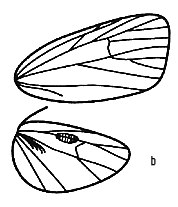|
Darantasia
Walker
Type
species: cuneiplena Walker, Singapore.
Synonyms: Coutha Walker (type
species semiclusa Walker, Indonesia); Peronetis
Meyrick (type species xenodora Meyrick,
New Guinea).
The striking patterning of this genus, and also of Nishada syntomioides (see Nishada syntomioides) is loosely similar to that of some
syntomine Arctiidae, and it is possible that mimicry is involved. The species
have been taken by day as well as at light. The wings are marked with yellow or
orange bars, streaks or patches on a black ground, though some of the Australian
taxa lack extensive black areas, being more yellow and brown. The forewings are
rather trapezoid, the hindwings narrow apart from, in the male at least, a
produced, rather lobed tornal area. The forewing venation (Fig. 10b) has a rather
symmetrical arrangement in the branching of veins around the end of the cell,
with M3 and CuA1 stalked as in the Lithosiini, but with venation reduced perhaps
by loss of a radial sector vein rather than M2. The male hindwing has a nodular
structure bearing scales on Rs within the cell. The male antennae are filiform.

Fig.10b: Darantasia cuneiplena Walker
The
male genitalia have an uncus with a bulbous or broad base that articulates in a
complex manner with the rather shouldered tegumen that ventrally is reflexed at
each side where it joins the vinculum, a broad saccus (distally excavate in
Bornean species) and an undivided valve that is distinctly narrower over the
apical third. The aedeagus is more strongly sclerotised apically where it
narrows into a produced apex; the vesica contains one or two bundles of small
cornuti. The eighth sternite is rectangular (broader transversely), with tufts
of hair-scales at the distal corners.
The
female has a distinctive biarcuate sterigma and a pyriform bursa with two signa
in the bulb consisting of patches of coarse spines (small, numerous in cuneiplena,
large, few in xenodora).
Apart
from the Oriental species referred to below, the genus is restricted to New
Guinea, with the greatest diversity, the Moluccas and, with one undescribed
species, the Solomons.
A
New Guinea species near D.
obliqua Hampson has been reared from Psychotria
spp. and Versteegia (Rubiaceae) by
a team led by S.E. Miller (pers. comm.), and
was probably feeding on these hosts rather than browsing on epiphytes.
<<Back
>>Forward <<Return
to Contents page
|

